An Analysis of Extreme Rainfall Events in Cambodia
Abstract
:1. Introduction
2. Materials and Methods
2.1. Descriptions of the Study Area
2.2. Rainfall Indices Analysis
3. Results
3.1. Spatial Analysis of Extreme Rainfall Indices
3.2. Temporal Analysis of Extreme Rainfall Indices
3.2.1. Tonle Sap Region
3.2.2. Coastal Region
3.2.3. Mekong Delta
3.2.4. Upper Mekong
3.3. Seasonal Rainfall Analysis
3.3.1. Extreme Rainfall Indices R95p and R99p
3.3.2. Dryness Analysis by Consecutive Dry Day Index
Tonle Sap Region
Coastal Region
Mekong Delta
Upper Mekong
4. Discussion
5. Conclusions
Author Contributions
Funding
Institutional Review Board Statement
Informed Consent Statement
Data Availability Statement
Acknowledgments
Conflicts of Interest
References
- Mohan Kumar, S.; Geethalakshmi, V.; Ramanathan, S.; Senthil, A.; Senthilraja, K.; Bhuvaneswari, K.; Gowtham, R.; Kannan, B.; Priyanka, S. Rainfall Spatial-Temporal Variability and Trends in the Thamirabharani River Basin, India: Implications for Agricultural Planning and Water Management. Sustainability 2022, 14, 14948. [Google Scholar] [CrossRef]
- Liu, Y.; Yuan, X.; Guo, L.; Huang, Y.; Zhang, X. Driving Force Analysis of the Temporal and Spatial Distribution of Flash Floods in Sichuan Province. Sustainability 2017, 9, 1527. [Google Scholar] [CrossRef]
- Xu, J.; Xu, L.; Wang, Y.; Ping, F.; Yin, L. Influence of Atmospheric Non-Uniform Saturation on Extreme Hourly Precipitation Cloud Microphysical Processes in a Heavy Rainfall Case in Zhengzhou. Sustainability 2023, 15, 15047. [Google Scholar] [CrossRef]
- Xie, C.; Huang, Y.; Li, L.; Li, T.; Xu, C. Detailed Inventory and Spatial Distribution Analysis of Rainfall-Induced Landslides in Jiexi County, Guangdong Province, China in August 2018. Sustainability 2023, 15, 13930. [Google Scholar] [CrossRef]
- Al-Ahmadi, K.; Al-Ahmadi, S. Rainfall-Altitude Relationship in Saudi Arabia. Adv. Meteorol. 2013, 2013, 363029. [Google Scholar] [CrossRef]
- Duong, S.; Song, L.; Chhin, R. Precipitation Projection in Cambodia Using Statistically Downscaled CMIP6 Models. Climate 2023, 11, 245. [Google Scholar] [CrossRef]
- Katsanos, D.; Retalis, A.; Tymvios, F.; Michaelides, S. Analysis of precipitation extremes based on satellite (CHIRPS) and in situ dataset over Cyprus. Nat. Hazards 2016, 83, 53–63. [Google Scholar] [CrossRef]
- Kunkel, K.E.; Karl, T.R.; Easterling, D.R.; Redmond, K.; Young, J.; Yin, X.; Hennon, P. Probable maximum precipitation and climate change. Geophysical Research Letters 2013, 40, 1402–1408. [Google Scholar] [CrossRef]
- Yazid, M.; Humphries, U. Regional observed trends in daily rainfall indices of extremes over the Indochina Peninsula from 1960 to 2007. Climate 2015, 3, 168–192. [Google Scholar] [CrossRef]
- Tandon, N.F.; Zhang, X.; Sobel, A.H. Understanding the Dynamics of Future Changes in Extreme Precipitation Intensity. Geophys. Res. Lett. 2018, 45, 2870–2878. [Google Scholar] [CrossRef]
- Thav, S.; Bunchhoeun, T.; Soryee, S.; Sokkheng, K.; Rano, K.; Sereyratana, B.; Sokchea, E.; Phy, O.; Sreyleak, A. Farmers’ perceptions on the impact of climate change: Case study of the agricultural sector of Cambodia. APN Sci. Bull. 2023, 13, 199–207. [Google Scholar] [CrossRef]
- Subyani, A. Topographic and seasonal influences on precipitation variability in southwest Saudi Arabia. J. King Abdulaziz Univ. Sci. 1999, 11, 89–102. [Google Scholar] [CrossRef]
- Tsujimoto, K.; Ohta, T.; Aida, K.; Tamakawa, K.; Im, M.S. Diurnal pattern of rainfall in Cambodia: Its regional characteristics and local circulation. Prog. Earth Planet. Sci. 2018, 5, 39. [Google Scholar] [CrossRef]
- Liu, L.; Bai, P.; Liu, C.; Tian, W.; Liang, K. Changes in extreme precipitation in the Mekong Basin. Adv. Meteorol. 2020, 2020, 8874869. [Google Scholar] [CrossRef]
- Lyon, B. The strength of El Niño and the spatial extent of tropical drought. Geophys. Res. Lett. 2004, 31, L21204. [Google Scholar] [CrossRef]
- Abhishek, A.; Das, N.N.; Ines, A.V.; Andreadis, K.M.; Jayasinghe, S.; Granger, S.; Ellenburg, W.L.; Dutta, R.; Quyen, N.H.; Markert, A.M.; et al. Evaluating the impacts of drought on rice productivity over Cambodia in the Lower Mekong Basin. J. Hydrol. 2021, 599, 126291. [Google Scholar] [CrossRef]
- Miyazawa, Y.; Tateishi, M.; Komatsu, H.; Ma, V.; Kajisa, T.; Sokh, H.; Mizoue, N.; Kumagai, T. Tropical tree water use under seasonal waterlogging and drought in central Cambodia. J. Hydrol. 2014, 515, 81–89. [Google Scholar] [CrossRef]
- Olson, K.R.; Morton, L.W. Tonle Sap Lake and River and confluence with the Mekong River in Cambodia. J. Soil Water Conserv. 2018, 73, 60A–66A. [Google Scholar] [CrossRef]
- Haberstroh, C.J.; Arias, M.E.; Yin, Z.; Sok, T.; Wang, M.C. Plastic transport in a complex confluence of the Mekong River in Cambodia. Environ. Res. Lett. 2021, 16, 095009. [Google Scholar] [CrossRef]
- Phoeurn, C.; Ly, S. Assessment of Satellite Rainfall Estimates as a Pre-Analysis for Water Environment Analytical Tools: A Case Study for Tonle Sap Lake in Cambodia. Eng. J. 2018, 22, 229–241. [Google Scholar] [CrossRef]
- Chhinh, N.; Millington, A. Drought Monitoring for Rice Production in Cambodia. Climate 2015, 3, 792–811. [Google Scholar] [CrossRef]
- Parsons, L.; Nielsen, J.Ø. The Subjective Climate Migrant: Climate Perceptions, Their Determinants, and Relationship to Migration in Cambodia. Ann. Am. Assoc. Geogr. 2020, 111, 971–988. [Google Scholar] [CrossRef]
- Sun, C.; Xiao, Z.-N.; Nguyen, M. Projection on precipitation frequency of different intensities and precipitation amount in the Lancang-Mekong River basin in the 21st century. Adv. Clim. Chang. Res. 2021, 12, 162–171. [Google Scholar] [CrossRef]
- Botkosal, W.; Kong, C.; Chanthou, C. The State of Climate Change in Cambodia. In Proceedings of the 5th AUN/SEED-Net Regional Conference on Global Environment, Bandung, Indonesia, 21–22 November 2012; pp. 1–14. [Google Scholar]
- Zhang, X.; Yang, F. RClimDex (1.0) user manual. Clim. Res. Branch Environ. Can. 2004, 22, 13–14. [Google Scholar]
- Sohrabi, M.; Marofi, S.; Ababaei, B. Investigation of temperature and precipitation indices by using RClimDex and R software in Semnan province. In Proceedings of the International Conference on Water Resources, Langkawi, Malaysia, 26–27 May 2009; pp. 16–18. [Google Scholar]
- Davison, A.C.; Gholamrezaee, M.M. Geostatistics of extremes. Proc. R. Soc. A Math. Phys. Eng. Sci. 2012, 468, 581–608. [Google Scholar] [CrossRef]
- Beguería, S.; Angulo-Martínez, M.; Vicente Serrano, S.M.; El Kenawy, A.M.; López-Moreno, J.I. Assessing trends in extreme precipitation events intensity and magnitude using non-stationary peaks-over-threshold analysis: A case study in northeast Spain from 1930 to 2006. Int. J. Clim. 2010, 31, 2102–2114. [Google Scholar] [CrossRef]
- Anagnostopoulou, C.; Tolika, K. Extreme precipitation in Europe: Statistical threshold selection based on climatological criteria. Theor. Appl. Clim. 2012, 107, 479–489. [Google Scholar] [CrossRef]
- Reveiu, A.; Dârdala, M. Techniques for Statistical Data Visualization in GIS. Inform. Econ. 2011, 15, 72. [Google Scholar]
- Krivoruchko, K.; Gotay, C. Using spatial statistics in GIS. In Proceedings of the International Congress on Modelling and Simulation, Townsville, Australia, 14–17 July 2003; pp. 713–736. [Google Scholar]
- Goodchild, M.F.; Longley, P.A.; Maguire, D.J.; Rhind, D.W. Geographic Information Systems and Science; John Wiley & Sons: Hoboken, NJ, USA, 2005; Volume 17, p. 517. [Google Scholar]
- Oeurng, C.; Cochrane, T.A.; Chung, S.; Kondolf, M.G.; Piman, T.; Arias, M.E. Assessing climate change impacts on river flows in the Tonle Sap Lake Basin, Cambodia. Water 2019, 11, 618. [Google Scholar] [CrossRef]
- Wang, Z.; Ficklin, D.L.; Zhang, Y.; Zhang, M. Impact of climate change on streamflow in the arid Shiyang River Basin of northwest China. Hydrol. Process. 2012, 26, 2733–2744. [Google Scholar] [CrossRef]
- Trenberth, K.E. The impact of climate change and variability on heavy precipitation, floods, and droughts. Encycl. Hydrol. Sci. 2005, 17, 1–11. [Google Scholar]
- Knowles, N.; Dettinger, M.D.; Cayan, D.R. Trends in snowfall versus rainfall in the western United States. J. Clim. 2006, 19, 4545–4559. [Google Scholar] [CrossRef]
- Mote, P.W. Trends in snow water equivalent in the Pacific Northwest and their climatic causes. Geophys. Res. Lett. 2003, 30, 1601. [Google Scholar] [CrossRef]
- Chen, C.; Noble, I.; Hellman, J.; Coffee, J.; Murillo, M.; Chawla, N. University of Notre Dame Global Adaptation Initiative—Country Index Technical Report; Notre Dame Global Adaptation Initiative: Notre Dame, IN, USA, 2024. [Google Scholar]
- Bank, T.W. Climate Risk Profile: Cambodia; World Bank Group: Washington, DC, USA; Asian Development Bank: Mandaluyong, Philippines, 2021. [Google Scholar]
- Stewart, M.A.; Coclanis, P.A. Environmental Change and Agricultural Sustainability in the Mekong Delta; Springer Science & Business Media: Berlin/Heidelberg, Germany, 2011; Volume 45. [Google Scholar]
- Kummu, M.; Sarkkula, J. Impact of the Mekong River flow alteration on the Tonle Sap flood pulse. AMBIO A J. Hum. Environ. 2008, 37, 185–192. [Google Scholar] [CrossRef]
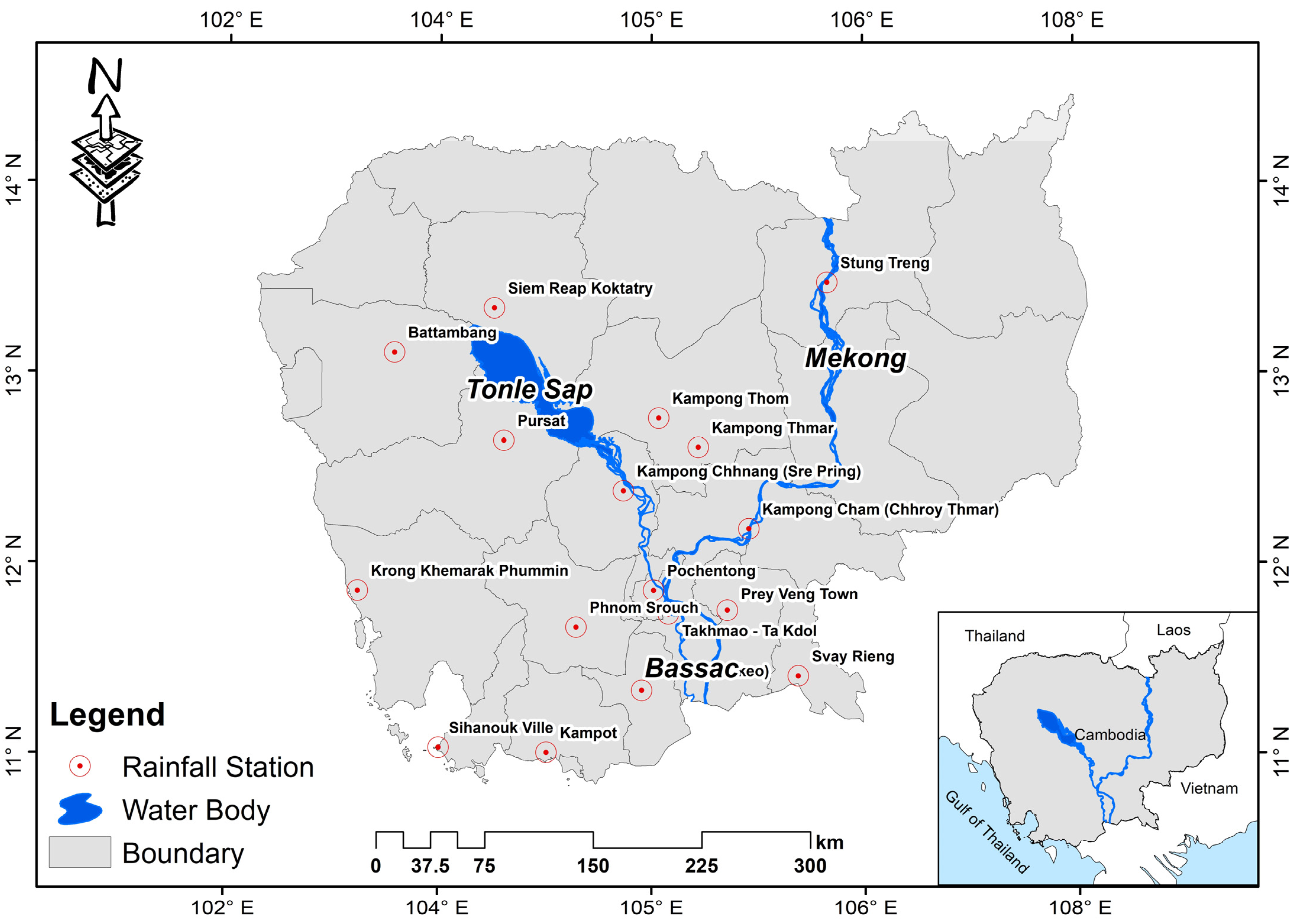
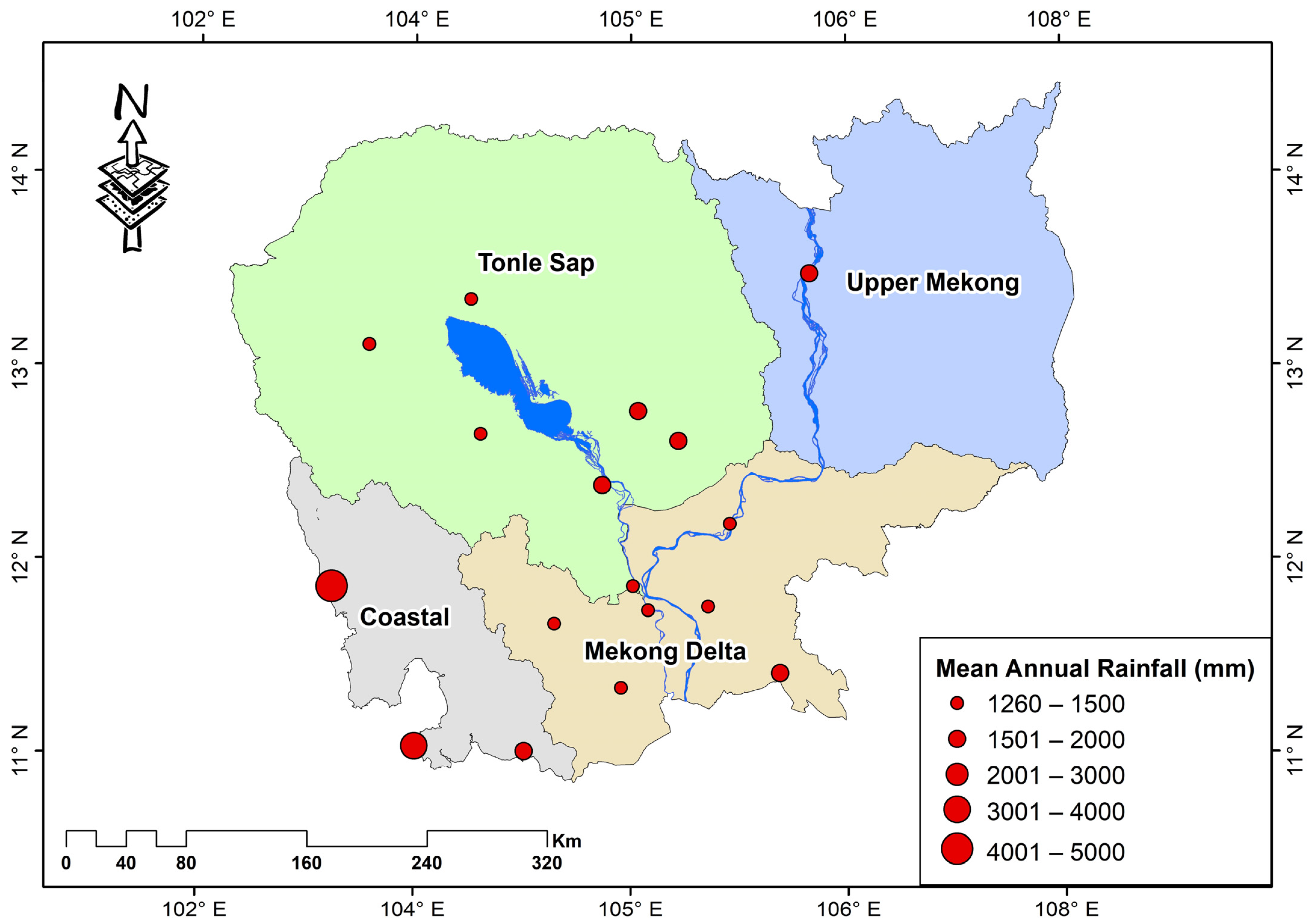
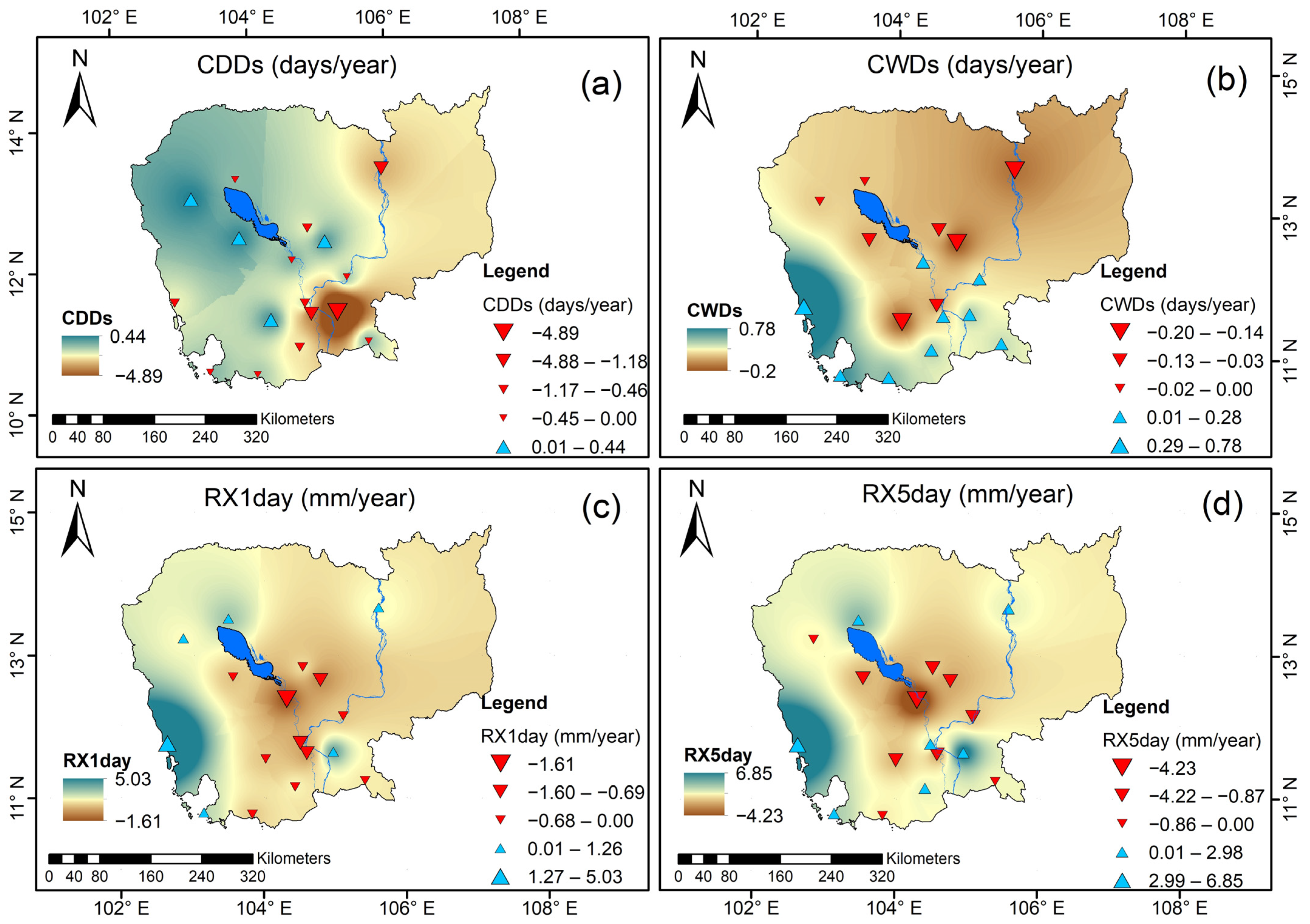

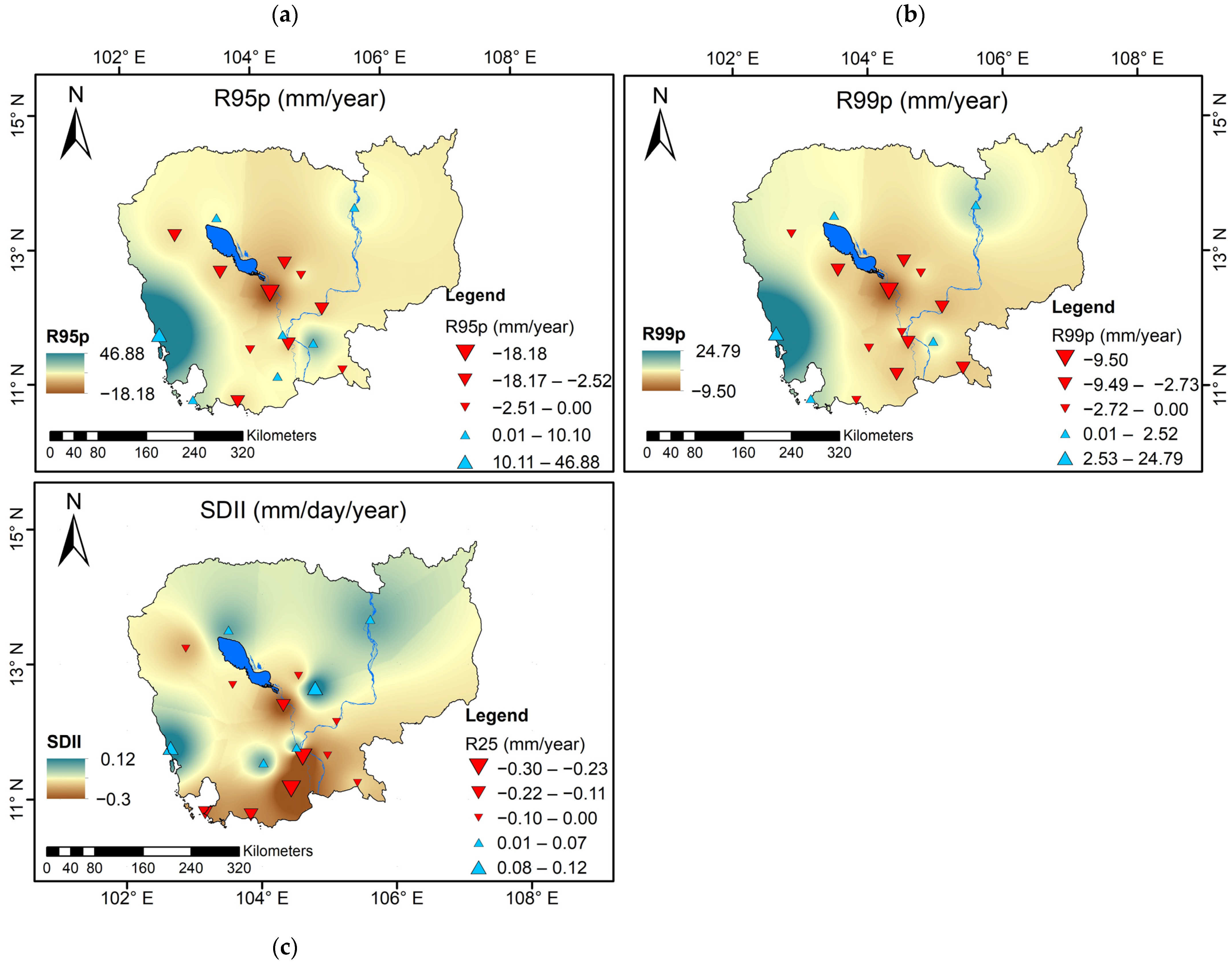
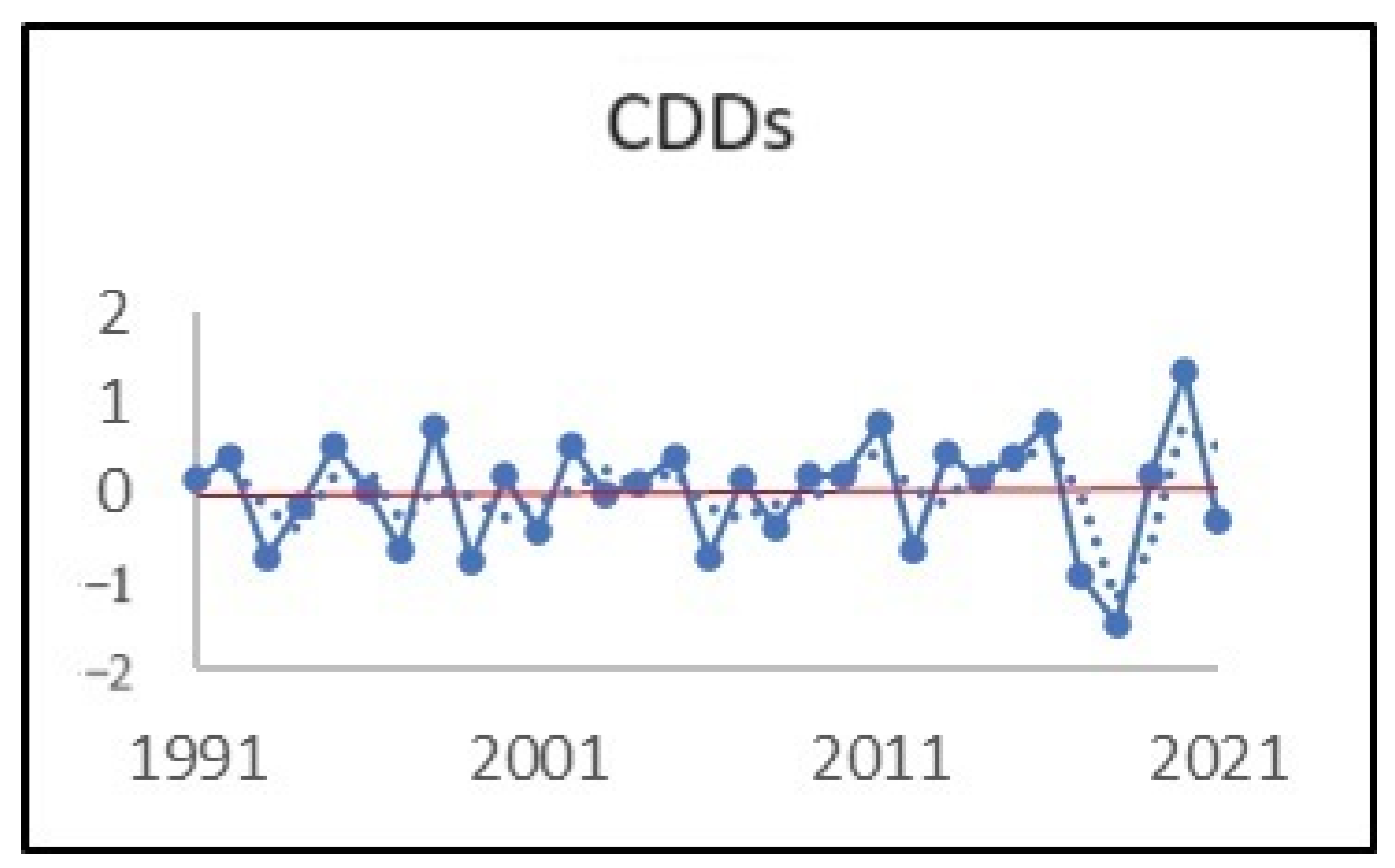
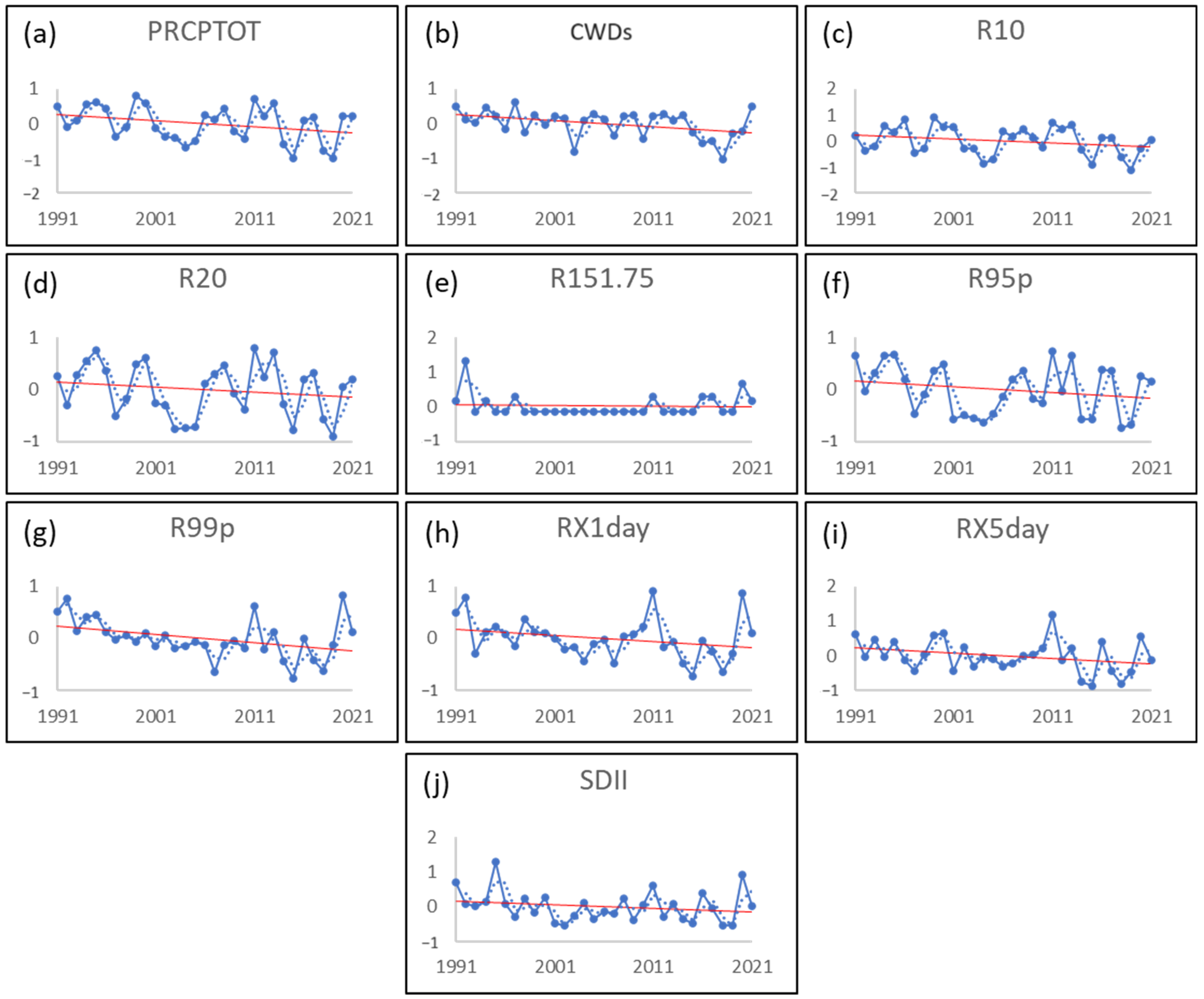
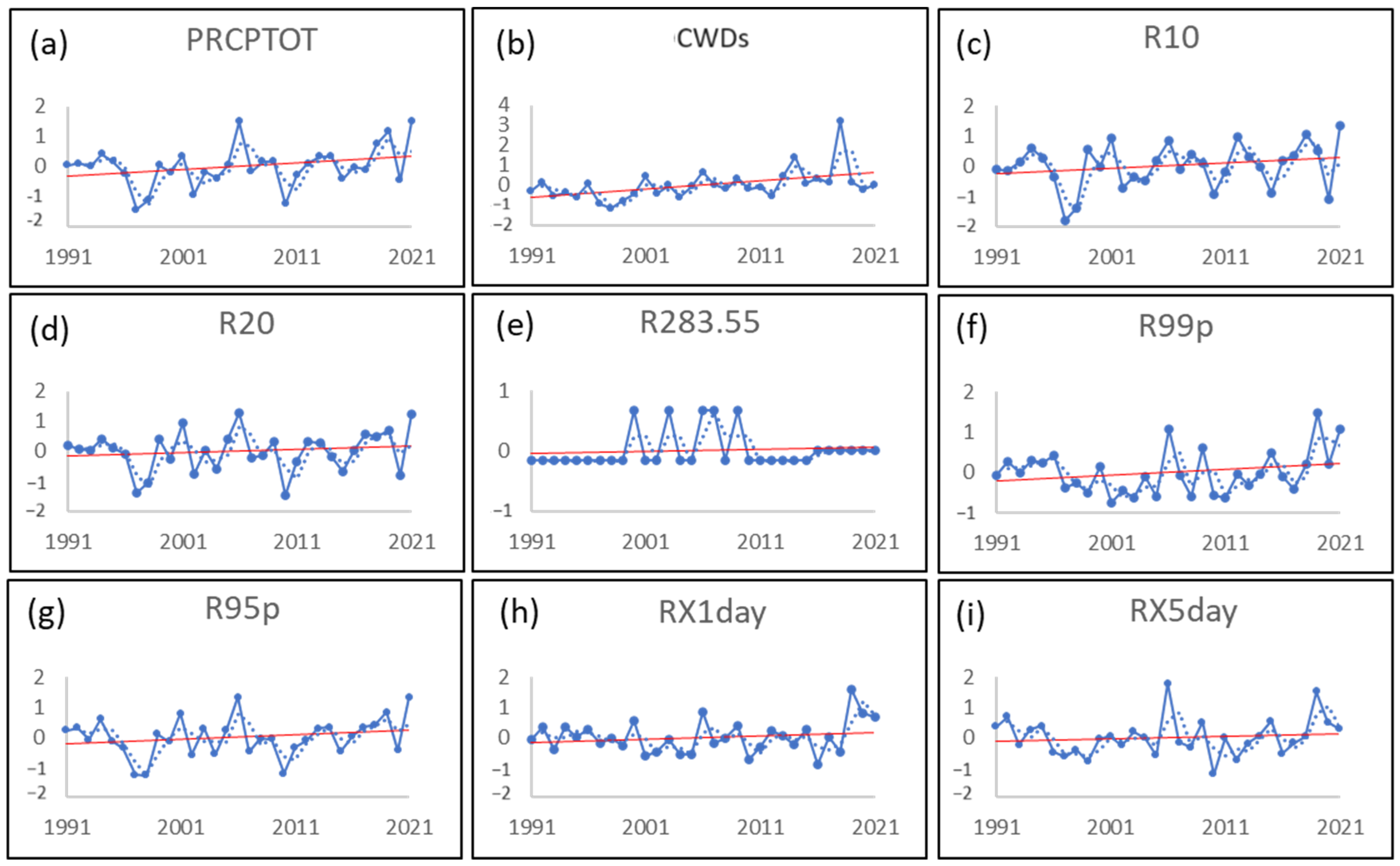

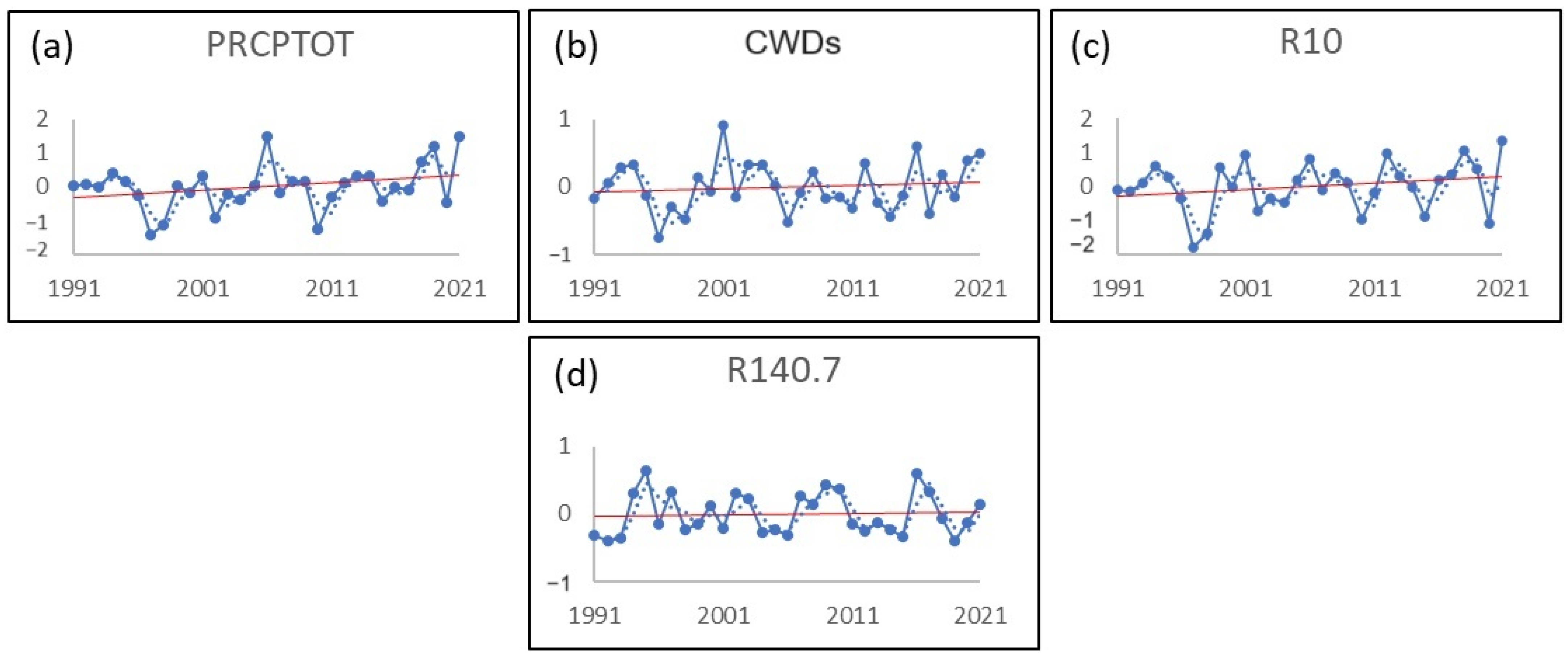
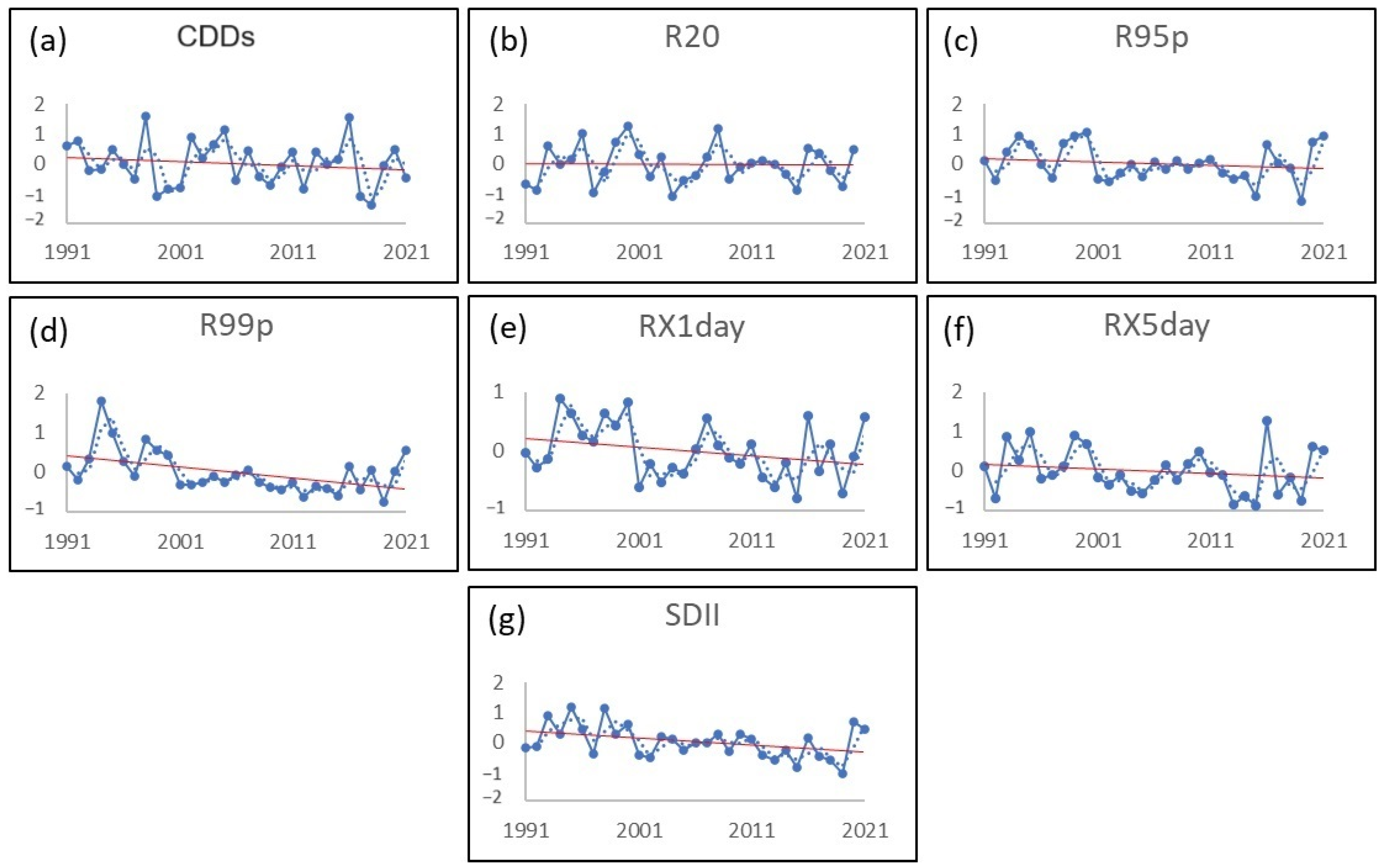



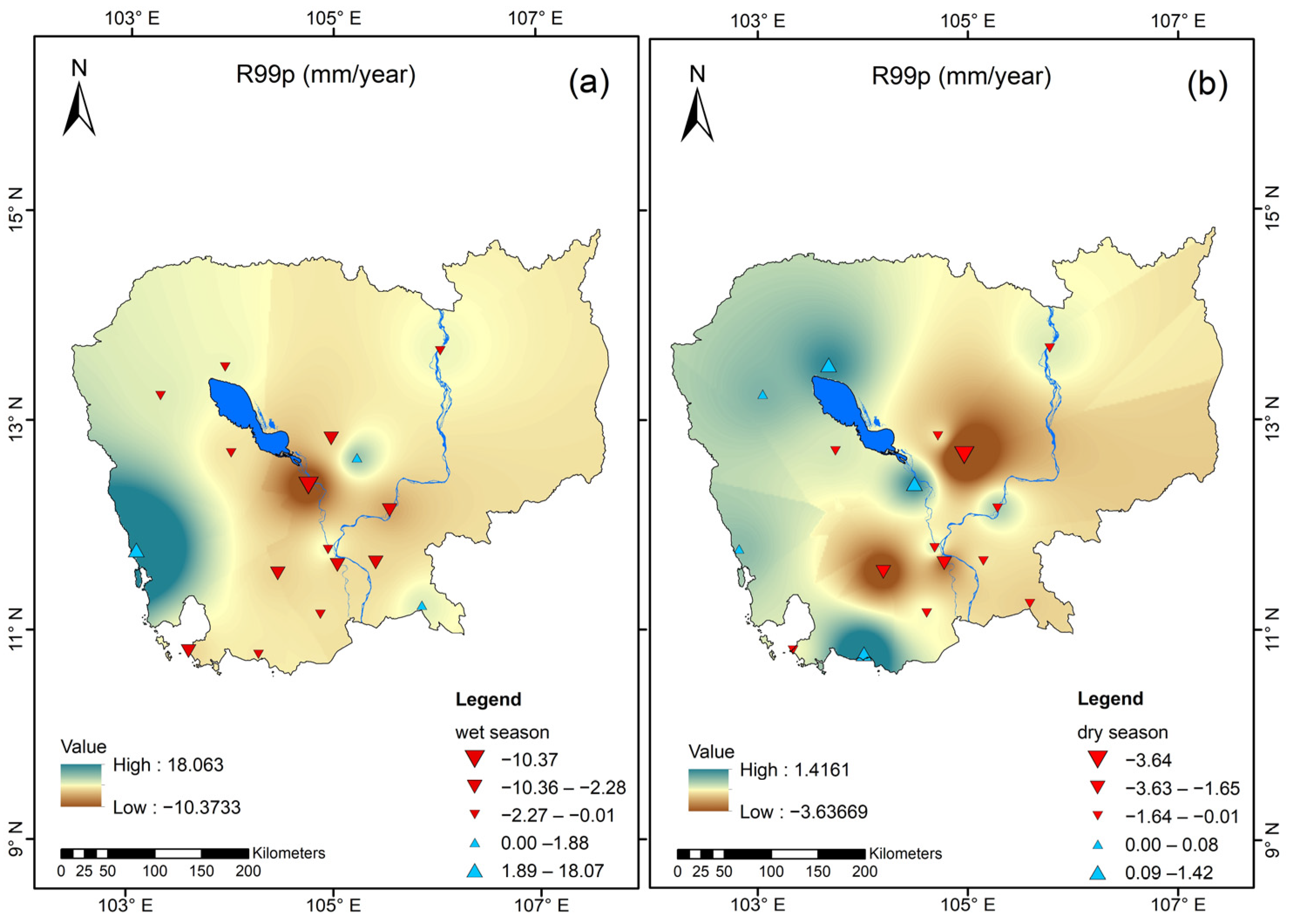



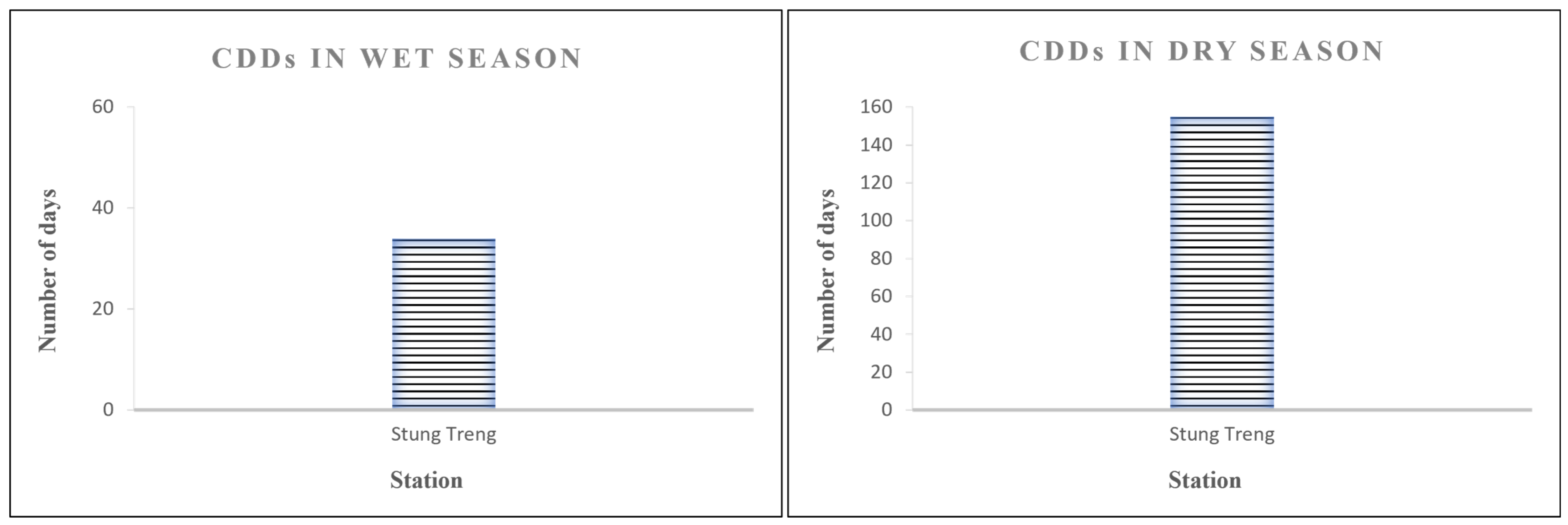
| No | Station ID | Station Name | Province | Geographic Coordinates | Rainfall Data Span [Years] | Time Period | Altitude [m] | |
|---|---|---|---|---|---|---|---|---|
| Longitude [° N] | Latitude [° E] | |||||||
| 1 | 100401 | Kampot | Kampot | 10.60281 | 104.18641 | 31 | 1991–2021 | 2 |
| 2 | 100420 | Takeo (Donkeo) | Takeo | 10.99000 | 104.79000 | 31 | 1991–2021 | 4 |
| 3 | 110409 | Takhmao—Ta Kdol | Kandal | 11.46678 | 104.95839 | 31 | 1991–2021 | 12 |
| 4 | 110413 | Phnom Srouch | Kampong Speu | 11.38382 | 104.37423 | 31 | 1991–2021 | 68 |
| 5 | 110425 | Pochentong | Phnom Penh | 11.61401 | 104.86477 | 31 | 1991–2021 | 11 |
| 6 | 110503 | Svay Rieng | Svay Rieng | 11.08000 | 105.78000 | 31 | 1991–2021 | 3 |
| 7 | 110514 | Prey Veng Town | Prey Veng | 11.48901 | 105.33222 | 28 | 1191–1994 1998–2021 | 8 |
| 8 | 120302 | Pursat | Pursat | 12.54389 | 103.91244 | 31 | 1991–2021 | 20 |
| 9 | 120401 | Kampong Chhnang (Sre Pring) | Kampong Chhnang | 12.23165 | 104.67273 | 31 | 1991–2021 | 19 |
| 10 | 120404 | Kampong Thom | Kampong Thom | 12.68541 | 104.8971 | 31 | 1991–2021 | 14 |
| 11 | 120423 | Kampong Thmar | Kampong Thom | 12.50226 | 105.14832 | 31 | 1991–2021 | 15 |
| 12 | 120504 | Kampong Cham (Chhroy Thmar) | Kampong Cham | 11.99462 | 105.4687 | 31 | 1991–2021 | 16 |
| 13 | 130305 | Battambang | Battambang | 13.09038 | 103.21419 | 31 | 1991–2021 | 15 |
| 14 | 130325 | Siem Reap Koktatry | Siem Reap | 13.37000 | 103.85000 | 31 | 1991–2021 | 17 |
| 15 | 130501 | Stung Treng | Stung Treng | 13.52819 | 105.96893 | 30 | 1191–1994 1996–2021 | 56 |
| 16 | 110303 | Krong Khemarak Phummin | Koh Kong | 11.60810 | 102.98805 | 25 | 1997–2021 | 5 |
| 17 | 100303 | Sihanouk Ville | Sihanouk Ville | 10.63317 | 103.50476 | 30 | 1992–2021 | 41 |
| Indices | Index Name | Descriptive Name | Unit |
|---|---|---|---|
| RX1day | Max. 1-day precipitation | Monthly maximum 1-day precipitation | mm |
| RX5day | Max. 5-day precipitation | Monthly maximum consecutive 5-day precipitation | mm |
| R10 | Number of heavy precipitation days | Annual count of days when PRCP ≥ 10 mm | days |
| R20 | Number of very heavy precipitation days | Annual count of days when PRCP ≥ 20 mm | days |
| Rnn | Number of days above nn (140.7, 151.75, 157, 283.55) mm | Annual count of days when PRCP ≥ nn mm; nn is user-defined threshold | days |
| CDDs | Consecutive dry days | Maximum number of PRCP when RR < 1 mm | days |
| CWDs | Consecutive wet days | Maximum number of PRCP when RR ≥ 1 mm | days |
| R95p | Very wet days | Annual total PRCP when RR > 95th percentile | mm |
| R99P | Extremely wet days | Annual total PRCP when RR > 99th percentile | mm |
| PRCPTOT | Annual total wet day precipitation | Annual total PRCP in wet days (RR≥ 1 mm) | mm |
| SDII | Simple daily intensity index | Annual total precipitation divided by the number of wet days (defined as PRCP ≥ 1 mm) in the year | mm/day |
| No | Station Name | Group 1 | Group 2 | Group 3 | ||||||||
|---|---|---|---|---|---|---|---|---|---|---|---|---|
| CDDs | CWDs | RX1day | RX5day | R10 | R20 | Rnn | PRCPTOT | R95p | R99p | SDII | ||
| 1 | Kampot | −0.286 | 0.188 | −0.359 | −0.377 | 0.115 | −0.008 | 0 | 3.334 | −2.765 | −0.86 | −0.111 |
| 2 | Takeo (Donkeo) | −0.849 | 0.141 | −0.006 | 0.094 | 0.179 | 0.049 | 0 | 7.833 | 0.396 | −2.725 | −0.234 |
| 3 | Takhmao—Ta Kdol | −1.549 | 0.037 | −0.837 | −1.451 | 0.2 | −0.059 | −0.004 | 2.769 | −4.814 | −3.972 | −0.304 |
| 4 | Phnom Srouch | 0.239 | −0.186 | −0.409 | −1.126 | 0.177 | 0.205 | −0.004 | −0.777 | −1.101 | −1.842 | 0.048 |
| 5 | Pochentong | −0.456 | −0.076 | −0.693 | 0.34 | 0.331 | 0.197 | −0.002 | 8.17 | 0.482 | −0.737 | 0.066 |
| 6 | Svay Rieng | −0.173 | 0.116 | −0.078 | −0.002 | −0.023 | 0.021 | 0 | 0.138 | −1.189 | −2.791 | −0.058 |
| 7 | Prey Veng Town | −4.892 | 0.151 | 1.259 | 2.982 | 0.826 | 0.522 | 0 | 32.50 | 10.10 | 1.225 | −0.094 |
| 8 | Pursat | 0.352 | −0.045 | −0.436 | −1.188 | −0.193 | −0.112 | 0 | −6.656 | −3.612 | −2.781 | −0.043 |
| 9 | Kampong Chhnang (Sre Pring) | −0.068 | 0.011 | −1.612 | −4.227 | −0.174 | −0.061 | −0.011 | −14.402 | −18.176 | −9.501 | −0.172 |
| 10 | Kampong Thom | −0.589 | −0.031 | −0.215 | −0.869 | −0.19 | −0.092 | 0 | −8.768 | −6.752 | −2.756 | −0.07 |
| 11 | Kampong Thmar | 0.193 | −0.199 | −0.988 | −1.369 | −0.172 | −0.061 | −0.016 | −5.695 | −1.012 | −1.338 | 0.119 |
| 12 | Kampong Cham (Chhroy Thmar) | −0.294 | 0.031 | −0.381 | −0.95 | −0.103 | −0.042 | 0.004 | −4.201 | −3.158 | −3.629 | −0.047 |
| 13 | Battambang | 0.435 | −0.009 | 0.113 | −0.248 | −0.31 | −0.185 | 0.006 | −6.762 | −2.518 | −0.14 | −0.083 |
| 14 | Siem Reap Koktatry | −0.112 | −0.014 | 0.796 | 1.252 | 0.269 | 0.213 | 0.07 | 7.127 | 0.401 | 0.206 | 0.044 |
| 15 | Stung Treng | −1.183 | −0.143 | 0.14 | 0.099 | 0.181 | 0.217 | −0.011 | 7.53 | 1.577 | 2.305 | 0.045 |
| 16 | Krong Khemarak Phummin | −0.612 | 0.78 | 5.032 | 6.854 | 0.995 | 1.04 | 0.008 | 89.94 | 46.884 | 24.785 | 0.107 |
| 17 | Sihanouk Ville | −0.093 | 0.284 | 0.569 | 0.803 | 0.019 | −0.166 | 0 | 2.448 | 4.296 | 2.516 | −0.112 |
Disclaimer/Publisher’s Note: The statements, opinions and data contained in all publications are solely those of the individual author(s) and contributor(s) and not of MDPI and/or the editor(s). MDPI and/or the editor(s) disclaim responsibility for any injury to people or property resulting from any ideas, methods, instructions or products referred to in the content. |
© 2024 by the authors. Licensee MDPI, Basel, Switzerland. This article is an open access article distributed under the terms and conditions of the Creative Commons Attribution (CC BY) license (https://creativecommons.org/licenses/by/4.0/).
Share and Cite
Pen, S.; Rad, S.; Ban, L.; Brang, S.; Nuth, P.; Liao, L. An Analysis of Extreme Rainfall Events in Cambodia. Atmosphere 2024, 15, 1017. https://doi.org/10.3390/atmos15081017
Pen S, Rad S, Ban L, Brang S, Nuth P, Liao L. An Analysis of Extreme Rainfall Events in Cambodia. Atmosphere. 2024; 15(8):1017. https://doi.org/10.3390/atmos15081017
Chicago/Turabian StylePen, Sytharith, Saeed Rad, Liheang Ban, Sokhorng Brang, Panha Nuth, and Lin Liao. 2024. "An Analysis of Extreme Rainfall Events in Cambodia" Atmosphere 15, no. 8: 1017. https://doi.org/10.3390/atmos15081017
APA StylePen, S., Rad, S., Ban, L., Brang, S., Nuth, P., & Liao, L. (2024). An Analysis of Extreme Rainfall Events in Cambodia. Atmosphere, 15(8), 1017. https://doi.org/10.3390/atmos15081017








